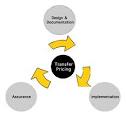Introduction
Textbooks in managerial accounting usually portray transfer pricing as an instrument for achieving decentralization and coordination in multidivisional firms. Accordingly, the role of transfer prices is to provide valuations for intermediate products and services so as to facilitate transactions across profit centers within a firm. For multinational firms, textbooks also emphasize the importance of tax considerations in the choice of transfer prices. Yet, the choice of transfer prices for tax purposes is typically portrayed as a tax compliance issue that remains conceptually separate from the managerial and economic dimensions of transfer pricing.
Transfer pricing
By definition, the most favorable arm’s length price minimizes the firm’s overall tax liability for given transfer quantities. If due to a conformity requirement the same price is used for managerial performance evaluation, the resulting intercompany transfers will be too low whenever the arm’s length price exceeds the pre-tax unit cost. The optimal single transfer price balances the conflicting goals of tax minimization and efficient resource allocation. We derive an upper bound for the tax related mark-up that a firm would seek to impose over and above its pre-tax cost when constrained to choose a single transfer price. Provided this cost-plus price is below the most favorable arm’s length price, the expected corporate profit after taxes will be maximized by a transfer price that does not minimize the firm’s tax burden ex-post.7
In recent years, Bangladesh has attracted some foreign direct investment, particularly in the natural gas sector. Bangladesh is trying to attract more foreign direct investment in order to foster growth and economic development and to exploit its natural resources. The principal foreign direct investors around the world are transnational corporations. Transnational corporations can engage in profit-shifting activities in order to maximize their risk-adjusted after-tax profit. If transnational corporations engage in profit-shifting activities, then these activities can have detrimental effects on the national exchequer.
How can the authorities prevent or reduce the scope for transnational corporations to engage in profit-shifting activities? It is argued here that the authorities may formulate prudential transfer pricing policies to try to deter detrimental profit-shifting activities of transnational corporations. Bangladesh’s transfer pricing policy could be based on generally accepted international principles. However, such principles have to be adjusted to the specific circumstances of the country and the administrative capability of the national tax authorities. Some features of a prudential transfer policy for Bangladesh are outlined and proposed.
There are many reasons for establishing a prudent transfer pricing policy in Bangladesh at a time when policy makers are actively seeking to encourage transnational corporations’ foreign direct investment in the country. Transactions among affiliates often take place under conditions different from those taking place between unrelated parties. The arm’s length principle stipulates that transactions priced among related parties should be in conformity with prices that would be charged between unrelated parties. The volume of transactions among related parties in international trade is substantial. The share of intra-firm transaction in trade increases as country’s trade grows and the pattern of trade is transformed through development. Finally, there should be consistency in the tax treatment of all similar transactions among affiliates of transnational corporations and independent firms. Thus, the authorities should have a well-defined, clearly articulated, consistent and coherent transfer pricing policy. It is hoped that the issues discussed in this paper will be useful to the authorities in setting a prudential transfer pricing regime in Bangladesh and will provide the basis for practical policy recommendations that can be implemented.
There is a substantial scholarly literature on the size, the scope, the growth and the structure of transnational corporations’ intra-corporate international trade (Bounturi and Fukasaku 1993; Clausing 2000; Eden 1998; Encarnation 1993; Hipple 1990a and 1990b;
Rangan 2000). National authorities, particularly in the United States and OECD countries, have also provided quantitative measures of intra-corporate international trade (Covari and Wisner 1993; Mataloni 1997; UNCTAD 1999; Whicard and Lowe 1995; 1998; and Zeilie 1997). Industry and consulting groups and professional service firms have also studied different aspects of intra-corporate international trade (Ernst and Young 1999; Krajewski 1992). However, at present the authorities in Bangladesh do not have an articulated transfer pricing policy. Issues related to transfer pricing in Bangladesh have not been rigorously studied. This paper attempts to initiate the task of filling this critical lacuna by outlining the basis for a prudential transfer pricing policy. The paper is structured as follows. Section I explains transfer pricing and the arm’s length principle. Section II provides a simple model that illustrates the role of transfer pricing in intra-firm international trade of the transnational corporation. Section III examines some simple empirics of (a) global intra-corporate trade and transfer pricing; and (b) transnational corporation’s presence and the tax regime in Bangladesh. Section IV covers the arm’s length principle, the basic foundation for prudential transfer pricing regime. Section IV furnishes the principal methods of transfer pricing. Section V presents some of the challenging issues in transfer pricing policy for Bangladesh. Section VI identifies further research topics on transfer pricing in Bangladesh. Section VII concludes.
Transfer Pricing Methods
There are several different types of methods for establishing transfer prices. These can be classified into three categories as follows: (a) Transactional methods; (b) Transactional profit methods; and (c) Unconventional methods. The different categories of the methods of transfer pricing are described below.
(a) Transactional Methods
Transactional methods are the most direct and effective means of establishing transfer price based on the arm’s length principle. Transaction based methods are the preferred methods of establishing transfer pricing. Three transactional methods are used for transfer pricing. These are described below.
Comparable uncontrolled price method: This method compares the price for the good or the intangible property transferred in a controlled transaction to the price charged for a good or an intangible property transferred in comparable uncontrolled transactions in a similar situation. The comparison verifies that the price for the good or intangible property transferred between affiliates is the same as would be charged if the product would have been sold in an arm’s length transaction. This method is appropriate when products are similar and when such unrelated transactions can be found. If, however, there are material differences for which adjustments cannot be made, this method is inappropriate and inapplicable. Problems with this method arise because often products are different in terms of designs and features, and many intermediate products are not traded in the open market.
Resale price method: This method uses the price at which a product that has been purchased from an affiliate is resold to an unrelated party. The resale price is reduced by the resale gross margin. What is left after subtracting the resale price margin after adjusting for other costs associated with the purchase of the product is an arm’s length price. Potential comparables are obtained from gross margins earned by unrelated parties, gross margins earned by the related party on transactions with unrelated buyers or re-sellers, and discounts provided by the related buyer or seller to unrelated buyers or resellers.
In order for the resale price method to be applicable there should be a substantial product-market and functional comparability in volume, terms of payment, contractual obligations, industry and market conditions, risks assumed, and so forth.
Cost-plus method: This method uses the cost incurred by the affiliate in a controlled transaction between the transnational corporation’s entities. An arm’s length price is arrived at by allowing an appropriate cost-up to be added to this cost. An appropriate surplus should be chosen in view of the functions performed and the market conditions.
The cost-markup should be based on comparing it with those of similar unrelated parties.
For this method to be valid, substantial product-market and functional comparability are required.
(b) Transactional Profit Methods
Though transaction based methods are the preferable means of obtaining transfer prices for intra-firm transactions, there are often practical difficulties in applying transaction methods. When no data are available, or available data are insufficient or of questionable quality, it may be necessary to resort to transactional profit methods. Transactional profit methods examine the profit that arises from particular controlled transactions. Profit arising from controlled transactions can be an indicator of whether the transaction was affected by conditions that differ from those that would have been made by unrelated parties in otherwise comparable circumstances. The application of the transactional profit methods can provide an approximation of transfer pricing in a manner consistent with the arm’s length principle. There are three transactional profit methods used for transfer pricing. These are described below.
Profit-split method: This method splits the combined profit from a controlled transaction among the concerned affiliates of the transnational corporation. The combined profit is split or allocated among the concerned entities based on an economically valid basis that approximates the division of profit that would have been anticipated and reflected in an arm’s length transaction with an independent customer.
Transactional net margin method: This method examines the net profit margin relative to an appropriate base (such as costs, sales, and assets) that the transnational corporation realized from a controlled transaction with its affiliates. The transactional net margin method should be applied in the same manner as the resale price or cost-plus method.
Comparable profit method: The comparable profit method determines an arm’s length result using the amount of operating profit that the tested party would have earned on related party transactions with other affiliates of the transnational corporation, if its profit level indicator were equal to that of an uncontrolled comparable transaction. Hence, the comparable operating profit of the affiliate would approximate what it would have earned in a transaction with an unrelated party.
(c) Unconventional methods
The authorities often resort to unconventional methods for transfer pricing when other methods are not applicable. There are two unconventional techniques used for transfer pricing that are worth mentioning. These are as follows: (a) advanced pricing agreement and (b) global formulary apportionment method.
Advanced Pricing Agreement: Advanced pricing agreement is an arrangement that determines, prior to a transaction among related parties, appropriate criteria for the determination of the transfer prices for those transactions over a fixed period of time.
Advance pricing agreement can be unilateral, bilateral, or multilateral. These agreements are initiated by a transnational corporation and require negotiations between the taxpayers, that is, the affiliates involved, and the tax authorities concerned. These agreements supplement conventional mechanisms for resolving transfer pricing issues, and are often useful when conventional methods are difficult to apply. Such agreements have numerous advantages, such as the elimination of uncertainty in tax treatment of cross-border transactions, the creation of non-adversarial relations between the taxpayer and the authorities, the reduction of costs, and so on.
Global Formulary Apportionment Method: Global formulary apportionment method is a method to allocate the global profits of the transnational corporation on a consolidated basis among its associated affiliates in different countries on the basis of a predetermined formula. There are three essential components to the application of this method: determining the unit to be taxed; accurately determining the global profits; and establishing the formula to be used to allocate the global profits of the unit. The formula is based on costs, assets, payroll, sales, or some combination of these. Formulary apportionment is not based on the arm’s length principle. There are many complex and practical problems that prevent it from developing a complete solution to the allocation of profits in a transnational corporate group. OECD (2000) explicitly rejects global formulary apportionment as a method for determining the proper level of profits across national tax jurisdictions.
Challenges in Transfer Pricing Issues
There are many challenging and complex issues in transfer pricing analysis. Transfer pricing analysis is a multi-step process. Transfer pricing process starts with the selection of the appropriate method. Once a method is selected, comparables have to be chosen.
The selected comparables need to be analyzed. This is followed by analysis of the tested party. Finally, applying the method to the tested party allows one to determine appropriate transfer prices. Transfer pricing regulations overlap with various tax issues.
Both corporate tax policy and double taxation treaties affect the countries’ transfer pricing regulations. In assessing the appropriate transfer prices of goods and services exchanged among affiliates the authorities need to undertake function analysis.
Functional analysis is a method of finding and organizing facts about a corporation in terms of its functions, risks and intangibles, in order to identify how these are allocated among the affiliates involved in the transaction under review.
Bangladesh’s transfer pricing regulations should be appropriate to the conditions of the country. Transactional methods should always be the preferred means for determining transfer pricing for tax assessment. However, when such methods cannot be used and suitable comparisons cannot be obtained the authorities may use transactional profit methods. There can also be provisions for the use of advanced pricing agreements. In rare cases the authorities may resort to global formulary apportionment even though this is at discord with the arm’s length principle.
The depth of documentation required for transfer pricing should be moderate. However all documentation should be contemporaneous and detailed. The transnational corporation should be required to maintain appropriate documents and be prepared to authenticate and file such documentation for examination and audit by the authorities.
The authorities should require the transnational corporations to make reasonable efforts to determine the transfer pricing in accordance with the arm’s length principle. The authorities should have the right to obtain the documentation from the corporation to verify compliance with the arm’s length principle. The burden of proof should fall on the taxpayer, not on the authorities. The authorities should impose high penalties for underpayment and non-compliance. Both the transnational corporation and the authorities should be responsible for transparency in all decisions concerning the determination of transfer prices for taxation. Transparency of process will help ensure credibility.
The authorities need to develop their capability for developing and implementing transfer price regulations. Multi-disciplinary capability is essential for the evaluation of transfer pricing. Knowledge of economics of industry, accounting, auditing, finance, law, management and marketing is required for assessing transfer pricing. The authorities would need to strengthen tax administration’s technical, surveillance, and database capabilities. Authorities would need qualified, trained, and skilled staff for designing, implementing, enforcing, and evaluating transfer price regulations. Adequate resources would be required to design, implement, enforce, and evaluate transfer pricing. The authorities need to establish various administrative procedures to minimize transfer pricing disputes and ensure transfer pricing compliance.
Customs valuation provides a useful consistency check for the validity of transfer pricing values. Taxpayers have diametrically opposite incentives in setting values for customs and corporate tax purposes. In general, a taxpayer importing goods is interested in setting low prices to them for customs purposes, so that the customs duty imposed will be low.
For tax purposes, however, the taxpayer may report a higher price paid for those goods in order to increase deductible costs. Given these incentives, the customs authorities would be primarily concerned with under-invoicing whereas the tax authorities would be mainly concerned about over-invoicing.
The transfer pricing value and the customs value of a good can be compared. The differences between transfer pricing value and customs value of a good will generally have an economic explanation. If there is systematic deviation of a transfer price and a customs value and no adequate explanation can be found, then it would convey a cautionary signal to the authorities that such cases may warrant an audit or an investigation. The existence of large outliers may be subject to investigation for possible tax avoidance or evasion. The size and the direction of the over- and underreporting of intra-firm transactions would be of interest. Econometric testing of deviations of customs value and transfer price may be useful. By obtaining information from customs authority, tax authorities can check whether the difference in the declared values are justified and do not represent an attempt to evade either income taxes or customs duties.
Customs valuation procedure and administration are likely to be more robust than the transfer pricing regime in developing and emerging market economies. Hence, it may be useful to rely on customs valuation for transfer pricing assessment, with appropriate adjustments as required. While transfer pricing and customs valuation are likely to be different between firms and across products, customs assessment is based on transaction values and on methods that are similar to that of transfer pricing. Hence, if the transfer pricing capabilities are not well developed, the authorities may be able to use customs assessment values. Given the competing incentives of under-invoicing for customs purpose but over-invoicing for transfer pricing, the tax authorities may use customs assessment valuation as a starting point for transfer pricing valuation. When alternative measures for comparable prices paid or payable for imports and received or receivable for imports are readily available such approximation may well suffice. Although there are substantial differences between the two, the similarities allow for the use of customs valuation in transfer pricing with proper adjustments as a first approximation, particularly in jurisdictions where the authorities’ transfer pricing assessment capabilities may be limited.
The authorities in Bangladesh should engage in information exchange with competent authorities abroad. Such information exchange will enable the authorities in assessing the tax liabilities of transnational corporations. The national authorities should enter into treaties with other countries to prevent double taxation and treaty shopping. Bangladesh already has bilateral investment treaties with 20 countries. There are double taxation treaties with 20 countries. The authorities will need to expand the number of bilateral treaties with more countries. The authorities should take advantage of cooperation and technical assistance provisions. The authorities should consider setting simultaneous examination agreements with foreign authorities.
Further Research Topics
Transfer pricing in Bangladesh is an issue of policy-relevant research. It touches on two key areas of research: (a) research on multinational corporations, and (b) research on tax issues and fiscal administration. Research on both these areas has been rather limited despite their importance to the growth and the development of the national economy.
There are many research areas on taxation, such as direct taxation, indirect taxation, local taxation, tax administration, tax evasion and tax avoidance, corruption and transparency.
There are also many areas of research on transnational corporations in Bangladesh.
Research on transnational corporations in Bangladesh should focus on their conduct, practice, structure, performance; pattern of direct investment; motivation and modality; financing, fund transfer, and cost of capital; incentives; transfer of technology; and employment. The research on transfer pricing should draw on the research and knowledge of both tax issues and transnational corporations in Bangladesh. Some of the topics of research on transfer pricing would pertain to the following issues: the magnitude of intra-firm transfers; the extent of usage of transfer pricing; transfer pricing methods used in practice; the influence of the company’s size, sectors, and national origins on the orientation of transfer pricing; environmental variables of transfer pricing; regulation and administration of regulations; and policy formulation, implementation, enforcement, and revisions.
Conclusion
Bangladesh should develop a comprehensive and detailed set of rules in relation to the establishment, maintenance, and documentation of transfer pricing policies and procedures and mechanism for resolving disputes. As Bangladesh tries to increase its attractiveness as a destination for transnational corporations, the authorities will have to face the practical issues of determining the income and expenses of firms that are subsidiaries of transnational corporate groups. The national tax authorities should be concerned with the possible erosion of the national tax base and adverse effect on local firms if transnational corporations have undue advantage due to profit-shifting activities through transfer pricing. Establishing and implementing a prudential transfer pricing policy would enable the authorities to reconcile the legitimate right to tax the profits of the transnational corporation based on the income arising from operating within the territory, with the need to avoid the taxation of the same item of income by more than one tax jurisdiction and to deter detrimental profit-shifting activities.
















